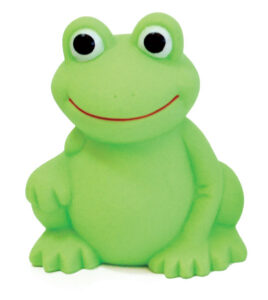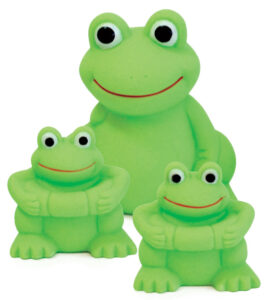Concentration
Toddlers watch a caregiver manipulate a toy frog that hops and stops hopping.



[Invite several toddlers to join you on the floor to watch a toy frog jump around. Move the frog up and down in a hopping motion as toddlers join you.]
We can have fun playing with a toy frog. Frogs like to hop. I am going to pretend our toy frog is hopping. Our frog will need help to go up and down.
 How can I help our frog to hop around?
How can I help our frog to hop around?
[Pause for toddlers to respond. Recognize each response. Example: “Casey is moving his hand up and down. Casey is telling us that a frog can hop up and down. I can move our frog up and down to help him hop!”]
Please watch how I help the frog hop.
[Move the frog up and down in a hopping motion for several moments as toddlers watch.]
I am moving the toy frog. Our frog is hopping.
Our frog is getting hungry! The frog stopped hopping because she is eating!
[Hold the frog still for the toddlers to see.]
I stopped moving our frog. The frog is not hopping. Our frog is eating!
[Begin moving the frog again.]
Our frog finished eating. The frog is hopping again. Hopping, hopping, hopping.
Now our frog is getting sleepy. Our frog is going to stop hopping because she wants to sleep. Last time, our frog stopped hopping because she was hungry. Now she stopped hopping because she is going to sleep.
[Hold the frog still for the toddlers to see.]
I stopped moving our frog. The frog is not hopping. The frog is sleeping.
I made our frog hop and then I made the frog stop hopping.
Should I make the frog hop one more time?
[If one or more toddlers respond positively, repeat the process of hopping and stopping the frog.]
I helped our frog hop. I moved our frog. We pretended the frog was hopping. Then I stopped moving our frog. Why did our frog stop hopping? (to eat and then to sleep)
We had fun watching the frog hop and then stop!
Concentration
Toddlers practice manipulating a toy frog that hops and stops hopping with caregiver guidance.



 Invite several toddlers to join you on the floor to play with some toy frogs. Introduce a toy frog by moving it up and down in pretend hopping movements. Describe what you are doing with the toy. Example: “Frogs get around by hopping. I am pretending that my toy frog is hopping.” Use up and down hand actions and move your arm to pretend the frog is going from Point A to Point B, and maybe to Points C and D!
Invite several toddlers to join you on the floor to play with some toy frogs. Introduce a toy frog by moving it up and down in pretend hopping movements. Describe what you are doing with the toy. Example: “Frogs get around by hopping. I am pretending that my toy frog is hopping.” Use up and down hand actions and move your arm to pretend the frog is going from Point A to Point B, and maybe to Points C and D!
Explain that we are going to have fun helping our toy frogs hop around. Give each toddler a toy frog. Allow time for toddlers to look at their frog and feel its shape. Point to the legs of the toy frog you are holding and invite toddlers to point to the legs on their frog. Explain that frogs use their legs to hop.
Invite toddlers to help their frog hop. Explain that you also will help your toy frog to hop and maybe toddlers would like to move their frog in the same way. Example: “Watch how I help my frog hop. You can help your frog hop like I am!”
After about a minute of hopping actions, explain that the frogs are getting hungry and it is time for our frogs to stop hopping. It is time for our frogs to eat. Draw attention to your frog. Example: “Let’s all stop moving our frogs. I stopped moving my frog. My frog is not hopping because she is eating. Your frogs are hungry too! We can let our frogs sit to eat.” Encourage toddlers to hold the toy frog with hands in their lap or put the frog on the floor to eat.
After a brief period of not moving the frogs, explain that the frogs are done eating and would like to hop some more. Manipulate your frog in hopping movements and encourage toddlers to do the same. After several moments of hopping actions, explain that the frogs are getting sleepy. It is time for the frogs to stop hopping because they need to sleep. Stop moving your frog and encourage toddlers to do the same. Example: “We stopped moving our frogs. Our frogs stopped hopping. The frogs are sleeping.” Again, encourage toddlers to hold the frog in their lap or put the frog on the floor.
Describe toddlers’ actions during the activity. Examples: “Jamar is moving his frog up and down. Jamar’s frog is hopping!” “We are moving our frogs. Our frogs are hopping!”
When you conclude the activity, acknowledge toddlers’ efforts to help their frog hop and then stop hopping. Emphasize “stop hopping” with a question, such as the following: “We had fun helping our frogs hop. What did we do so our frogs could eat and also sleep?” (stopped the hopping, stopped moving them)
Concentration
Toddlers practice manipulating a toy frog that hops and stops hopping with minimal caregiver guidance.



Invite several toddlers to join you on the floor to play with toy frogs. Give each toddler a toy frog to hold and explore. Point out the legs of the frog. Explain that frogs move around by hopping. A frog uses its leg to hop. Demonstrate how to help the toy frog hop. Use up and down hand actions and move your arm to pretend the frog is going from Point A to Point B, and maybe to Points C and D!
Explain that each of us will help a toy frog hop around. Our frogs also will need to stop to eat and stop again to sleep. Demonstrate how to stop the hopping by holding the frog in your lap or putting the frog on the floor.
Invite toddlers to help their frogs hop around and to listen for you to say when it is time to stop the hopping. Encourage toddlers to move their frogs. Do not move your frog unless a brief demonstration seems needed. Offer a stop request after about a minute of hopping actions. This stop is for the frogs to eat. After a brief period for eating, invite toddlers to again help their frogs hop. Offer a second stop request after a brief period of moving the toy frogs in hopping actions. This stop is so the frogs can sleep. Describe toddlers’ actions during the activity. Examples: “Bradley’s frog is making big hops! All the frogs are hopping!” “Jordan stopped moving her frog. Her frog is not hopping.”
The second stop request is the end of the activity. Conclude the activity by recognizing toddlers’ efforts in (a) helping their frog hop, (b) stopping the hopping, and (c) listening carefully to know when it was time to hop and to stop hopping.
The three options promote skills in concentrating on and controlling (stopping) simple physical movements. Your level of support differs significantly across the options, from demonstration (Option 1) to nominal support of toddlers in practicing the actions (Option 3). In Options 2 and 3, watch for signs of toddlers needing help in following the requests. Your contributions to Option 3 can shift to Option 2 strategies, if necessary.
Although the activity is primarily focused on concentration skills, it also promotes motor development. Pay attention to how much complexity in frog manipulations seems sufficiently challenging for toddlers. A basic approach is to move a hand up and down, in hopping motions. A more advanced movement is to add arm movements that pretend the frog is moving from one location to another. Arm movements are also involved in higher hopping actions that some toddlers may initiate. It may be difficult for some toddlers to coordinate hand and arm movements (hopping while moving to different areas).
Extra support
Enrichment
Materials Needed: toy frogs and other pond animals (ducks, fish, turtles), water table or tub with 1–2 inches of warm water
Place the frogs and pond animals in a small amount of water. Invite toddlers to play with the figures in the water. Encourage them to practice helping the figures hop/swim and then stop to eat or rest. A toddler may wish to manage two frogs at the same time, assuming materials and space are available.
Update: The book originally featured in this activity (Five Green and Speckled Frogs by Pricilla Burris) may be difficult to secure. An alternative book has been added.
Materials Needed: toy frogs and other pond animals, such as ducks, fish, turtles; Hop Jump by Ellen Stoll Walsh or, if available, Five Green and Speckled Frogs by Priscilla Burris
Read one of the books with all children. If you share the Five Green and Speckled Frogs book, keep in mind that toddlers are not expected to count. Older children may enjoy counting with the book story. Children of all ages will enjoy holding a frog or pond animal to make it hop/swim and then stop. Toddlers and older children may want to move their bodies like frogs during the activity. Nonmobile infants will enjoy being held and moved around like a hopping frog.